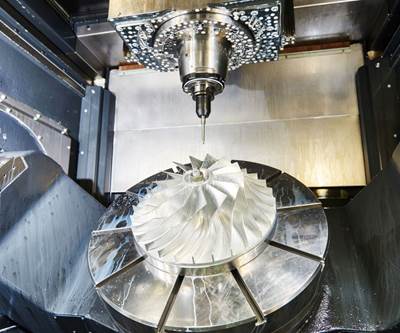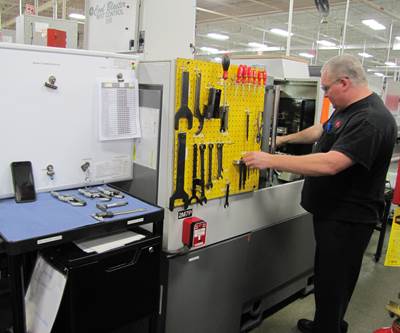8 Ways to Increase Productivity on the Manufacturing Floor
When it comes to machine shop productivity, continuous improvement depends on efficient employees, equipment and processes.
Share






Regardless of the size of your business, continuous improvement in productivity is essential to enhancing gross profits and maintaining competitiveness. Productivity on the machine shop floor depends on a combination of efficient employees, equipment and processes. Continuous improvement in all of these areas involves examining the current practices in place and making adjustments to systems, employee training and even the equipment used to generate parts and components.
Before you can adopt any method for continuous improvement for productivity, you will need to measure your existing output levels, create a baseline and implement solutions for measuring change. Shane Strowski, president of Precision Waterjet & Laser, shares the following eight steps to help you improve productivity and success on the shop floor.
1. Examine Your Production Workflow
The first step is all about identifying pain points in your current workflow. Analyze the people, technology and processes required for production as well as the procedures, communication tools and resources available across the company. Consider using value mapping as a way of identifying and monitoring projects for continuous improvement; this strategy enables managers to pinpoint issues and record how changes impact the overall system.
2. Update Machine Shop Processes
Share current workflow problems with project managers to develop continuous improvement plans for the manufacturing process. This could mean reassigning resources to different areas of the manufacturing floor, managing budgets or becoming ISO-certified. Be sure to systematically evaluate performance and interpret any appropriate changes.
3. Invest in Training and Employee Education
The manufacturing and metalworking industries are constantly changing. There’s always a new technology promising to make manufacturing floors more efficient than ever. Technological advancements often change the skills required for certain tasks, and workers will require access to regular training to keep up with more advanced specialist skills.
4. Have Realistic Expectations
Client expectations, pressures regarding production and strict deadlines can contribute to unrealistic goals. When workload benchmarks on the manufacturing floor are unattainable without some compromise to safety or quality, employees become dissatisfied, preventing the company from reaching labor goals. To boost worker efficiency, it’s important to set realistic, clearly defined objectives that ensure a combination of punctuality, high-quality output and safe procedures.
5. Buy Smarter Machine Tools
Manufacturing is an industry in which an employee can only be as productive as their tools. While innovative machines such as waterjets or CNC machining centers can be costly in terms of initial setup and training, advanced equipment can have a positive long-term effect. Manufacturing companies often find that a machinery upgrade helps them stay competitive in a new and innovative market.
6. Invest in Maintenance
There’s a link between the costs associated with downtime and the time and budget invested in preventive measures. While new equipment can boost productivity, it also requires maintenance to ensure that it continues working at an optimum level. It is important that employees know how to troubleshoot instances of system downtime to quickly find root causes of errors. Don’t be too quick to blame the tool for problems. Remember to think about the process, the blueprint, the material and more.
7. Stay Organized
The number of lost dollars and wasted labor hours that result from a lack of organization can be surprising. One surefire way to enhance productivity in any environment is to ensure that there is a well-organized place for everything: from materials to machine tools and documents. When organizing your work area as part of continuous improvement, think about the layout of your machining equipment and tools and whether they currently maximize efficiency. If not, consider rearranging your manufacturing floor to create a smoother workflow.
8. Encourage Collaboration
The shop floor is most productive when everyone works together toward the same goal with as little waste and conflict as possible. While focusing on work is important, it’s also crucial to ensure that each staff member feels comfortable as part of a team. The better the members of your team can work together, the more they will encourage a productive workplace culture. Continuous improvement takes culture as well as process and technology into account.
Related Content
Finding the Right Tools for a Turning Shop
Xcelicut is a startup shop that has grown thanks to the right machines, cutting tools, grants and other resources.
Read MoreHow to Pass the Job Interview as an Employer
Job interviews are a two-way street. Follow these tips to make a good impression on your potential future workforce.
Read MoreBuilding Machines and Apprenticeships In-House: 5-Axis Live
Universal machines were the main draw of Grob’s 5-Axis Live — though the company’s apprenticeship and support proved equally impressive.
Read MoreSame Headcount, Double the Sales: Successful Job Shop Automation
Doubling sales requires more than just robots. Pro Products’ staff works in tandem with robots, performing inspection and other value-added activities.
Read MoreRead Next
Before You Buy That New Machine Tool, Consider the Workpiece
Among the many important questions to answer before purchasing a new machine tool is what size and sort of workpiece it will be machining.
Read MoreThe Three Pillars of Reliable Machine Shop Productivity
This shop looks for a systematic convergence of three disciplines in production management.
Read More
































